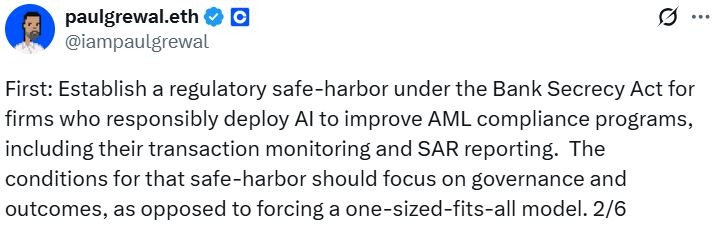Coinbase urges the US Treasury to adopt blockchain analytics, AI, and other advanced technologies to combat increasingly sophisticated money laundering in crypto. This approach modernizes anti-money laundering efforts under the Bank Secrecy Act, enhancing law enforcement’s ability to detect illicit activities efficiently.
-
Coinbase’s letter highlights the need for innovative tools like AI and APIs to counter evolving financial crimes in digital assets.
-
Regulatory exceptions under the Bank Secrecy Act could encourage companies to integrate these technologies without hesitation.
-
According to official US Treasury data from the August 18 notice, innovative methods are essential for detecting illicit digital asset activities, as required by the GENIUS Act.
Coinbase pushes US Treasury for AI and blockchain analytics to fight crypto money laundering. Discover how these tools can modernize AML compliance and boost financial security. Read expert insights now.
What is Coinbase’s Recommendation on Using AI and Blockchain to Combat Crypto Money Laundering?
Coinbase’s recommendation on using AI and blockchain to combat crypto money laundering centers on leveraging modern technologies to address sophisticated financial crimes. In a letter dated October 17, 2025, Chief Legal Officer Paul Grewal emphasized that money laundering schemes now employ advanced tech, requiring law enforcement to adopt similar innovations like blockchain analytics and artificial intelligence. This aligns with the Anti-Money Laundering Act of 2020’s goal to update the Bank Secrecy Act for the digital era.
How Can Regulatory Clarity for AI and APIs Improve Anti-Money Laundering in Crypto?
Regulatory clarity for AI and APIs can significantly improve anti-money laundering (AML) in crypto by providing companies with safe harbors under the Bank Secrecy Act. Grewal noted that firms hesitate to fully deploy AI-driven monitoring tools due to unclear guidelines, which stifles innovation. Establishing governance-focused conditions rather than rigid models would encourage adoption. For APIs, standardizing use cases with defined data privacy and interoperability standards would enable seamless integration across platforms. Expert analysis from the American Enterprise Institute supports this, indicating that such measures could reduce compliance costs while strengthening detection capabilities. Short sentences highlight key benefits: faster transaction scrutiny, reduced false positives, and enhanced cross-border cooperation. Official statistics from the US Treasury’s August 18, 2025, notice underscore the urgency, revealing that illicit crypto activities routed through blockchains demand these proactive steps.
Crypto exchange Coinbase has submitted a detailed response to the US Treasury’s request for comments on deterring illicit activities in digital assets. The submission, led by Chief Legal Officer Paul Grewal, advocates for the integration of blockchain analytics, artificial intelligence, and other cutting-edge tools to modernize financial crime prevention. This initiative responds directly to the Treasury’s August 18, 2025, notice, which sought public input on innovative detection methods as mandated by the GENIUS Act. The comment period closed on October 18, 2025.
In his letter, Grewal pointed out that money laundering tactics have evolved with technology, making traditional methods insufficient. “Blockchain and other innovative technologies can counter these emerging risks,” he wrote. “Treasury and other policymakers should promote their use to identify and deter illicit activity.” This push supports broader regulatory updates, including those from the Anti-Money Laundering Act of 2020, aimed at refreshing the Bank Secrecy Act for the cryptocurrency landscape.
Coinbase’s Chief Policy Officer, Faryar Shirzad, echoed these sentiments in a public statement on October 20, 2025. He called for the US government to emulate crypto exchanges by embracing “innovation to modernize AML with proven digital tools like AI, APIs, digital IDs, and blockchain analytics.” Such tools have already proven effective in real-world applications, including major seizures by agencies like the Secret Service.

Source: Faryar Shirzad
Regulatory Clarity for AI and API Key to Battling Financial Crime
Among the key proposals in Grewal’s letter is a regulatory exception for companies employing AI and Application Programming Interfaces (APIs) in AML monitoring. This safe harbor would prioritize governance and measurable outcomes over uniform approaches. “The conditions for that safe-harbor should focus on governance and outcomes, as opposed to forcing a one-sized-fits-all model,” Grewal stated in a follow-up comment on October 20, 2025.

Source: Paul Grewal
The lack of clear regulations has made companies cautious about fully utilizing AI in AML processes. Grewal explained that without defined boundaries, firms risk non-compliance penalties, hindering technological progress. For APIs, challenges include inconsistent standards and fragmented regulations across jurisdictions. Treasury guidance outlining acceptable use cases could address this by specifying data privacy requirements and interoperability protocols. This would allow businesses to integrate APIs confidently, streamlining compliance programs and improving efficiency in tracking suspicious transactions.
Blockchain technology also requires clearer rules to maximize its potential in AML efforts. Grewal recommended that the Treasury issue guidance recognizing decentralized identities and zero-knowledge proofs as legitimate customer verification methods. Additionally, blockchain analytics for clustering transactions should be incentivized for compliance purposes. He stressed the importance of facilitating information sharing about potential illicit blockchain activities without imposing excessive recordkeeping on all participants. This balanced approach would enhance transparency while respecting privacy principles inherent to decentralized systems.
The US Treasury’s notice, published on August 18, 2025, invited feedback on novel strategies to identify and mitigate risks in digital asset transactions. Coinbase’s response, submitted before the October 18 deadline, positions the exchange as a leader in advocating for tech-forward regulations. By drawing on internal expertise and industry best practices, the proposal aims to create a more resilient framework against financial crimes.
Think Tank Proposes Alternative Communication System for Law Enforcement
While Coinbase focuses on technological adoption, other experts offer complementary perspectives. Jim Harper, a non-resident Senior Fellow at the American Enterprise Institute, suggested establishing a direct communication system between law enforcement and crypto firms. In a blog post on October 20, 2025, building on his September 15, 2025, paper, Harper argued that this setup would enable targeted queries for investigations.
“Such a system would maintain or strengthen law enforcement capabilities while obviating the existing broad and costly financial surveillance regime,” Harper wrote. This method could replace overly intrusive monitoring with precise, on-demand information sharing, reducing burdens on legitimate users. The American Enterprise Institute’s analysis highlights how current regimes often capture unnecessary data, increasing operational costs for the industry. Harper’s proposal aligns with broader discussions on privacy-preserving technologies in crypto regulation.
Coinbase has demonstrated its commitment to combating financial crime through practical actions. For instance, the exchange played a key role in the Secret Service’s largest-ever cryptocurrency seizure, showcasing the effectiveness of collaborative tech solutions. These efforts underscore the need for policies that harness innovation rather than stifle it.
Frequently Asked Questions
What Specific Technologies Does Coinbase Recommend for Crypto AML Compliance?
Coinbase recommends blockchain analytics, artificial intelligence, APIs, digital IDs, and zero-knowledge proofs for crypto AML compliance. These tools enable real-time detection of suspicious activities, aligning with the Anti-Money Laundering Act of 2020. By promoting their use, regulators can modernize enforcement without overburdening the industry, as outlined in the October 17, 2025, letter to the Treasury.
How Will AI Integration Change Law Enforcement’s Approach to Crypto Money Laundering?
AI integration will transform law enforcement’s approach to crypto money laundering by automating pattern recognition in complex blockchain transactions, making investigations faster and more accurate. It reduces reliance on manual reviews, allowing agencies to focus on high-risk cases. As Paul Grewal noted, clear regulatory safe harbors would encourage widespread adoption, ultimately strengthening global financial security through efficient, data-driven methods.
Key Takeaways
- Adopt Modern Tech for AML: Blockchain analytics and AI are essential to counter sophisticated money laundering, supporting the Bank Secrecy Act’s modernization goals.
- Seek Regulatory Exceptions: Safe harbors for AI and APIs would boost innovation by focusing on outcomes, addressing current compliance hesitations as per expert recommendations.
- Enhance Communication Systems: Direct law enforcement queries to crypto firms could streamline investigations, reducing broad surveillance costs while maintaining effectiveness.
Conclusion
In summary, Coinbase’s recommendation on using AI and blockchain to combat crypto money laundering offers a forward-thinking path for regulatory clarity in AML efforts. By incentivizing technologies like blockchain analytics and decentralized IDs, the US Treasury can build a robust defense against illicit finance. As the crypto sector evolves, these measures will foster innovation and trust. COINOTAG encourages readers to stay informed on upcoming policy developments and consider how these advancements impact digital asset security. Published October 21, 2025; Last updated October 21, 2025.







